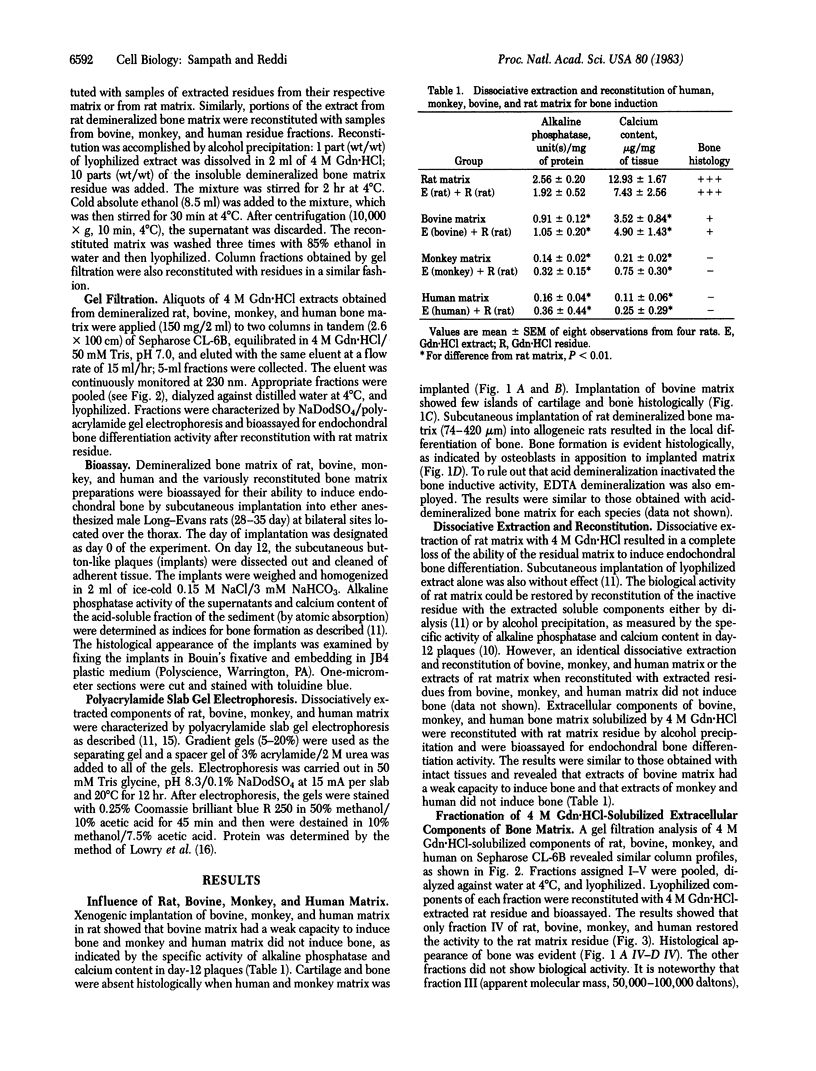Abstract
Allogeneic implantation of rat extracellular demineralized diaphyseal bone matrix in subcutaneous sites induces a sequence of events resulting in the local differentiation of endochondral bone. However, xenogenic subcutaneous implantation of human, monkey, and bovine extracellular bone matrix into rat showed that bovine matrix had only a weak capacity to induce bone, whereas human and monkey matrix had none at all. This suggested that extracellular matrix-induced bone differentiation is apparently species-specific. We recently reported that the extraction of matrix with 4 M guanidine X HCl resulted in complete removal of the ability to induce endochondral bone differentiation, with the biological activity of the matrix being again restored when the extracted active matrix components (less than 50,000 daltons) were reconstituted with the inactive residue. To define the possible biochemical basis of species specificity, human, monkey, and bovine extracellular bone matrices were extracted with 4 M guanidine X HCl and the extracts were reconstituted with biologically inactive rat residue and bioassayed. The results were similar to those obtained with intact matrices and showed that total extracts of bovine matrix had a weak capacity to induce bone, whereas corresponding extracts of human and monkey matrix did not induce bone. However, partial purification by gel filtration of 4 M guanidine X HCl extracts from each species followed by reconstitution of the different fractions with inactive rat residue resulted in bone induction by all species from fractions containing proteins of less than 50,000 daltons. These observations demonstrate that species specificity of xenogenic extracellular bone matrix is due to immunogenic or inhibitory components (or both) in the guanidine X HCl residue and solubilized extracellular matrix components of greater than 50,000 daltons. These results imply that there is homology in the bone inductive proteins from human, monkey, bovine, and rat extracellular bone matrices.
Full text
PDF




Images in this article
Selected References
These references are in PubMed. This may not be the complete list of references from this article.
- Folkman J., Greenspan H. P. Influence of geometry on control of cell growth. Biochim Biophys Acta. 1975 Dec 31;417(3-4):211–236. doi: 10.1016/0304-419x(75)90011-6. [DOI] [PubMed] [Google Scholar]
- Glowacki J., Kaban L. B., Murray J. E., Folkman J., Mulliken J. B. Application of the biological principle of induced osteogenesis for craniofacial defects. Lancet. 1981 May 2;1(8227):959–962. doi: 10.1016/s0140-6736(81)91730-x. [DOI] [PubMed] [Google Scholar]
- Gospodarowicz D., Greenburg G., Birdwell C. R. Determination of cellular shape by the extracellular matrix and its correlation with the control of cellular growth. Cancer Res. 1978 Nov;38(11 Pt 2):4155–4171. [PubMed] [Google Scholar]
- Huggins C., Wiseman S., Reddi A. H. Transformation of fibroblasts by allogeneic and xenogeneic transplants of demineralized tooth and bone. J Exp Med. 1970 Dec 1;132(6):1250–1258. doi: 10.1084/jem.132.6.1250. [DOI] [PMC free article] [PubMed] [Google Scholar]
- LOWRY O. H., ROSEBROUGH N. J., FARR A. L., RANDALL R. J. Protein measurement with the Folin phenol reagent. J Biol Chem. 1951 Nov;193(1):265–275. [PubMed] [Google Scholar]
- Laemmli U. K. Cleavage of structural proteins during the assembly of the head of bacteriophage T4. Nature. 1970 Aug 15;227(5259):680–685. doi: 10.1038/227680a0. [DOI] [PubMed] [Google Scholar]
- Reddi A. H., Anderson W. A. Collagenous bone matrix-induced endochondral ossification hemopoiesis. J Cell Biol. 1976 Jun;69(3):557–572. doi: 10.1083/jcb.69.3.557. [DOI] [PMC free article] [PubMed] [Google Scholar]
- Reddi A. H. Cell biology and biochemistry of endochondral bone development. Coll Relat Res. 1981 Feb;1(2):209–226. doi: 10.1016/s0174-173x(81)80021-0. [DOI] [PubMed] [Google Scholar]
- Reddi A. H., Huggins C. B. Formation of bone marrow in fibroblast-transformation ossicles. Proc Natl Acad Sci U S A. 1975 Jun;72(6):2212–2216. doi: 10.1073/pnas.72.6.2212. [DOI] [PMC free article] [PubMed] [Google Scholar]
- Reddi A. H., Huggins C. B. Influence of geometry of transplanted tooth and bone on transformation of fibroblasts. Proc Soc Exp Biol Med. 1973 Jul;143(3):634–637. doi: 10.3181/00379727-143-37381. [DOI] [PubMed] [Google Scholar]
- Reddi A. H., Huggins C. Biochemical sequences in the transformation of normal fibroblasts in adolescent rats. Proc Natl Acad Sci U S A. 1972 Jun;69(6):1601–1605. doi: 10.1073/pnas.69.6.1601. [DOI] [PMC free article] [PubMed] [Google Scholar]
- Sampath T. K., DeSimone D. P., Reddi A. H. Extracellular bone matrix-derived growth factor. Exp Cell Res. 1982 Dec;142(2):460–464. doi: 10.1016/0014-4827(82)90389-5. [DOI] [PubMed] [Google Scholar]
- Sampath T. K., Reddi A. H. Dissociative extraction and reconstitution of extracellular matrix components involved in local bone differentiation. Proc Natl Acad Sci U S A. 1981 Dec;78(12):7599–7603. doi: 10.1073/pnas.78.12.7599. [DOI] [PMC free article] [PubMed] [Google Scholar]
- Stoker M., O'Neill C., Berryman S., Waxman V. Anchorage and growth regulation in normal and virus-transformed cells. Int J Cancer. 1968 Sep 15;3(5):683–693. doi: 10.1002/ijc.2910030517. [DOI] [PubMed] [Google Scholar]
- Urist M. R. Bone: formation by autoinduction. Science. 1965 Nov 12;150(3698):893–899. doi: 10.1126/science.150.3698.893. [DOI] [PubMed] [Google Scholar]
- Urist M. R., DeLange R. J., Finerman G. A. Bone cell differentiation and growth factors. Science. 1983 May 13;220(4598):680–686. doi: 10.1126/science.6403986. [DOI] [PubMed] [Google Scholar]










